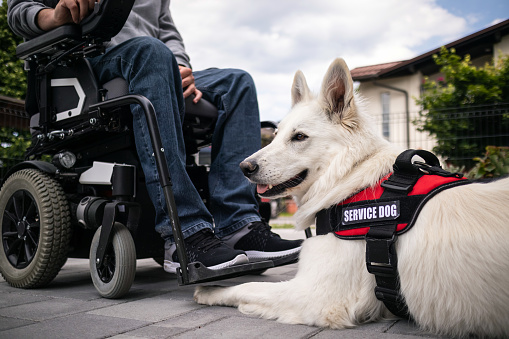
The different types of assistance animals as well as the tasks they perform is a topic that concerns both people with physical and/or mental disabilities and the public. Knowing the essential differences between Service Animals, Emotional Support Animals, and Therapy Animals will help us better understand the rights and responsibilities of the handler-dog teams and behave adequately when around them.

Service Animals
Many people with disabilities benefit from the tasks that their service animals perform for them. According to the Americans with Disabilities Act (ADA) service animals are dogs individually trained to perform tasks for people with physical and/or mental impairments. The tasks that the dog has been trained to perform must be directly related to their owner’s disability. In order to be eligible for a service dog, a person must have a physical or mental disability, that “substantially limits one or more major life activity”. Also, individuals who do not currently have an impairment, but a record of such disability, are included.
As the definition of “service animals” indicates, these animals can be only dogs. However, some states such as Arizona, Florida, Illinois, Iowa, Michigan, Mississippi, Montana, Nevada, New Mexico, Ohio, South Carolina, Tennessee, Washington, Wyoming, also accept miniature horses as service animals.
You should keep in mind that you will be unable to turn your cat, bird, or another domesticated species, unless it is a dog, into a service animal.
Types of Service Animals
Service animals can be divided into different types based on the tasks they have been trained to perform, i.e.:
Mobility and Balance Tasks
Mobility/balance service animals have been trained to support individuals with physical impairments. Some tasks that this type of service animal has been trained to perform include:
⊛ pulling a wheelchair;
⊛ assisting the handler to change their position, i.e. if they are in a sitting position and want to stand;
⊛ helping the handler to climb stairs/go downstairs;
⊛ providing balance during a walk
In most cases, service dogs who perform mobility tasks, wear a harness equipped with a sturdy grip.
Retrieving Tasks
Training their service dogs to retrieve objects can be helpful not only for physically impaired people but also for people with mental impairments, as in certain cases they may be unable to reach the wanted items themselves, i.e.:
⊛ they are on medication and feel dizzy;
⊛ they have an episode and are disconnected from reality.
Guiding Tasks
These tasks are especially related to people with visual impairments and may include:
⊛ guiding the handler home;
⊛ guiding the handler to the exit of a building;
⊛ guiding the handler to a specific: person, location, object, item;
⊛ guiding the handler to a safe place.
Alert Tasks
Alert tasks include a wide range of tasks such as:
⊛ alerting the handler about an oncoming seizure;
⊛ alerting the handler about an oncoming heart attack;
⊛ alerting the handler about changes in the blood sugar levels;
⊛ alerting the handler about a fire alarm/cooking alarm;
⊛ alerting the handler about someone ringing the doorbell / knocking on the door.
Psychiatric Tasks
Psychiatric Service Dogs are a type of service animal, officially recognized by the ADA. These are dogs specially trained to perform tasks related to mitigating the symptoms of mental disabilities like PTSD, panic disorder, anxiety, and depression. The most common psychiatric tasks that service dogs can be trained to perform are:
⊛ Deep Pressure Therapy;
⊛ tactile stimulation;
⊛ grounding the handler (bringing them back to reality after an episode has occurred).
The tasks that service dogs can perform can be divided into one more type and namely:
Interactions with Other People
These tasks may include various interactions with family members/friends or employees such as:
⊛ bringing a note to a specific person;
⊛ delivering an item to a person;
⊛ finding a specific person;
⊛ find help, as needed.
If you would like to learn more about the tasks that service dogs can perform, you can read our article: “Service Dogs Tasks”.
Service Dogs Rights
Service dogs in the US are protected under the ADA, and they must be granted access to all places free to use by the public. Since service dogs are considered medical equipment, and not pets, the “no pets” policy of covered entities does not apply to them. Hence, they may not be denied access to public premises based on stereotypes about the breed or how the service dog might behave.
Service Dogs Exclusion
Service dogs may be excluded in the following cases:
“The ADA does not require covered entities to modify policies, practices, or procedures if it would “fundamentally alter” the nature of the goods, services, programs, or activities provided to the public. Nor does it overrule legitimate safety requirements. If admitting service animals would fundamentally alter the nature of a service or program, service animals may be prohibited. In addition, if a particular service animal is out of control and the handler does not take effective action to control it, or if it is not housebroken, that animal may be excluded.”
Service Dogs Registration and Certification
Service dogs in the US are not required to be registered or certified. However, if your local laws require all dogs to be registered and licensed, this applies to your service dog as well.
It is important to note that people with disabilities in the US are allowed to train their own dogs and are not required to have them professionally trained.
Service Dogs Training Gear
Handlers in the US are not obligated to put special training gear such as vests/harnesses on their service animals.
“The ADA does not require service animals to wear a vest, ID tag, or specific harness”.

Emotional Support Animals
Emotional Support Animals (ESA) are animals that provide companionship and comfort to their owners. They are not trained to perform specific tasks directly related to a certain disability but their presence has a positive effect on the emotional state of their owner. Unlike service animals, ESA are not limited to dogs (and miniature horses in some states) and all types of domesticated species such as dogs, cats, rabbits, birds...etc., can become Emotional Support Animals.
Are Emotional Support Animals and Psychiatric Service Dogs the Same?
No. Both terms should not be confused. Psychiatric Service Dogs perform specific tasks directly related to mental disabilities, hence they must be granted the same access rights that service dogs have.
Are Emotional Support Animals Protected under the ADA?
No. Since they are not deemed service animals, ESA are not protected under the ADA. Whether they will be allowed on public premises, depends on the local laws as well as on the pet policy of the facility.
Emotional Support Animals Rights
ESA are not protected under the ADA, as they are not service animals and may be denied access to public places. Also they are not allowed to travel in the passenger cabin. You can read more about the new regulations for flying with service animals in our article “New 2022 Rules and Restriction for Flying with Service Dogs (and ESA)”.
However, ESA still must be granted reasonable accommodation, since they are protected under the Fair Housing Act.
According to the Bazelon Center for Mental Health Law:
“The Fair Housing Amendments Act of 1988, Section 504 of the Rehabilitation Act of 1973, and Title II of the Americans with Disabilities Act protect the right of people with disabilities to keep emotional support animals, even when a landlord's policy explicitly prohibits pets. Because emotional support and service animals are not "pets," but rather are considered to be more like assistive aids such as wheelchairs, the law will generally require the landlord to make an exception to its "no pet" policy so that a tenant with a disability can fully use and enjoy his or her dwelling. In most housing complexes, so long as the tenant has a letter or prescription from an appropriate professional, such as a therapist or physician, and meets the definition of a person with a disability, he or she is entitled to a reasonable accommodation that would allow an emotional support animal in the apartment”.
According to the ADATA- ADA National Network:
“There have been numerous complaints, administrative hearings, and court cases regarding the obligation of covered entities under FHA to allow individuals with disabilities to live with their assistance animals. There seems to be no dispute that whatever the animal is “called”—e.g., emotional support animal, or service animal—all must be considered as a reasonable accommodation to the rules or policies of a housing provider.”
How to Make Your Pet an Emotional Support Animal
In order to to that, you need to consult a mental health professional and be provided with a letter to verify your need for an ESA.
We would like to note that medical notes used to verify person’s need for an ESA can not substitute a doctor’s note as proof for a person’s need for a service animal.
ESA Registration
Similar to service dogs, handlers in the US are not required to register their Emotional Support Animals.

Therapy Animals
The term “pet therapy” is used to describe a guided interaction between an individual and a trained animal and usually includes the animal’s handler as well. Pet therapy is typically provided as a part of a therapy plan to help a person recover quicker or be able to deal with a physical or a mental issue.
Similar to Emotional Support Animals, Therapy Animals are not limited to dogs only (although dogs are most commonly used as therapy animals) and may include domesticated species like cats, horses, guinea pigs...etc. What animal will be chosen for a patient, depends on the therapy plan.
How Does Animal Therapy Work
The art of the therapy may vary, based on the patient needs. It may include:
- providing emotional support and comfort;
- helping the patient improve their motor skills;
- helping a person improve their social and behavioral skills
- helping a person improve their learning skills (i.e. students);
- motivating the patient engage in different activities and socialize actively
In general, dog owners, who are in many cases the dog handlers as well, visit different types of facilities, usually as volunteers. Handlers will have to work under the guidance of a professional health provider while participating in different therapy sessions with their dogs. In order to be allowed on the premise, both the handler and the dog will have to go through training and get certified. Although therapy animals are not supposed to perform certain tasks, they should be obedient, calm and friendly and be able to fulfill basic obedience commands. Animal’s temperament will be evaluated so that it will be granted that he/she will behave properly around people. Also, the animal’s health will be examined, so that it will be verified that he/she is healthy and vaccinated up to date. The handler, on the other hand, may need visit courses where they will be thought how to interact with people in certain situations. There are organizations that prepare handlers and their dogs for the work as therapy team and connect them with certain facilities.
Animal Assisted Therapy (AAT) vs Animal Assisted Activities (AAA)
Both terms are used to describe programs that include animals who assist people easily go through a process of healing or learning.
While animals included in AAA help people improve their education, motivation and different types of activities to enhance their life quality. Although it is not so formal in its nature as the AAT is, it still needs to be provided by a trained professional or a handler-animal team, that meets certain requirements.
AAT, on the hand, focuses on the goals that need to be accomplished according to a therapy plan. In other words, AAT is considered “goal-oriented”. It is a planned and structured intervention that is usually managed by health and human service providers.
Therapy Animals Rights
Therapy Animals are not service animals, as they are not trained to perform tasks directly related to a certain disability. Hence they are nor protected under federal laws and may be denied access to public premises as well as in the passenger cabin.
Therapy Animals Registration
There is no official Therapy Animals registry.












